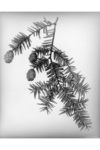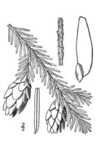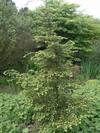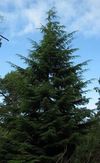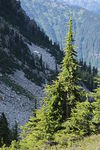Genus Tsuga
Tsuga mertensiana Mountain HemlockSpecies in the genus Tsuga of plants
Eastern hemlock - The eastern hemlock grows well in shade and is very long lived, with the oldest recorded specimen being at least 554 years old.
Carolina hemlock - It is an evergreen coniferous tree growing up to 30 m tall and 110 cm in trunk diameter under forest conditions. The crown is compact and pyramidal, growing up to 8 m wide. The bark is thick, reddish-brown and becomes fissured between scaly ridges. The branches are stout and usually horizontal, but often slightly drooping. The shoots are red-brown to orange-brown, finely hairy. The leaves are 5-20 mm long and 1.8–2 mm broad, flattened, not tapering toward their ends, and with a rounded or slightly notched apex; they radiate outward in all directions from the twigs and smell of tangerine if crushed. They are glossy dark green above and paler on the underside with two white stomatal bands. The cones are 2-4 cm long, green, maturing light to mid-brown 6–7 months after pollination. When fully open, their scales are positioned at a right angle or reflexed to the central axis.
Chinese hemlock - T. chinensis is a large tree with bark that is a blackish brown in colour. The scaly bark has irregular longitudinal breaks, and lenticels that are very inconspicuous. The outer bark is about 6 mm thick with alternating tiered layers of pale yellowish brown corky bark, and brown lignified fibrous bark. The newly formed periderm is a purplish red. The inner bark is about 4 to 5 mm thick and pale reddish brown in colour. It is fibrous in texture with minute, almost inconspicuous sclereid, or stone cell groups. The cambium as well as the newly formed phloem are nearly inconspicuous. Freshly cut wood is a pale yellowish white with inconspicuous wood rays.
Northern Japanese hemlock - T. diversifolia is an evergreen tree that attains heights of 25 m . The crown is narrow, dense and conical. Young shoots are short, palely pubescent and bright orange to red-brown in colour. The densely arranged needles are linear-oblong and 5 to 15 mm long and up to 2.4 mm wide. They are a dark green in colour, glossy and furrowed above with two chalk white stomatal bands below.
Himalayan hemlock - T. dumosa is a tree growing 20 to 25 metres high and exceptionally to 40 m . The diameter at breast height is typically 40 to 50 cm , but can be beyond 100 cm .
Western hemlock - Tsuga heterophylla is an integral component of Pacific Northwest forests west of the Coast Ranges, where it is a climax species. It is also an important timber tree throughout the region, along with many of its large coniferous associates.
Tsuga mertensiana - Tsuga mertensiana is a large evergreen coniferous tree growing to 20–40 m—60–120 feet tall, with exceptional specimens at 59 m-180 feet tall. They have a trunk diameter of up to 2 m-6 feet. The bark is thin and square-cracked or furrowed, and gray in color. The crown is a neat slender conic shape in young trees with a tilted or drooping lead shoot, becoming cylindric in older trees. At all ages, it is distinguished by the slightly pendulous branchlet tips. The shoots are orange-brown, with dense pubescence about 1 mm long. The leaves are needle-like, 7–25 mm long and 1–1.5 mm broad, soft, blunt-tipped, only slightly flattened in cross-section, pale glaucous blue-green above, and with two broad bands of bluish-white stomata below with only a narrow green midrib between the bands; they differ from those of any other species of hemlock in also having stomata on the upper surface, and are arranged spirally all round the shoot.

